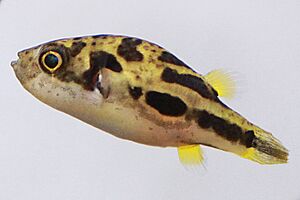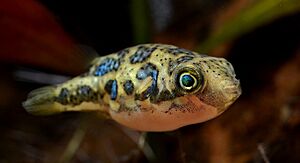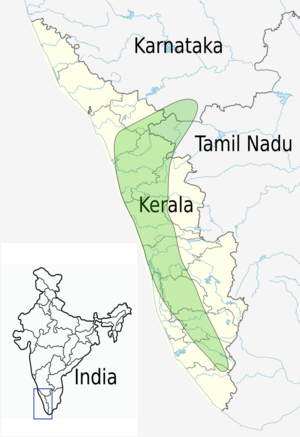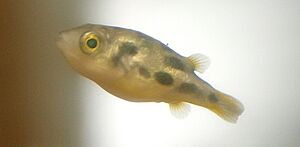Dwarf pufferfish facts for kids
The dwarf pufferfish (Carinotetraodon travancoricus), also known as the Malabar pufferfish, pygmy pufferfish, or pea pufferfish, is a tiny freshwater pufferfish. It lives only in Kerala and southern Karnataka in Southwest India. These fish are popular in aquariums because they are small and have bright colors. At only 3.5 cm (about 1.4 inches) long, dwarf pufferfish are among the smallest pufferfish in the world. They look a lot like another fish called Carinotetraodon imitator, and it can be hard to tell them apart. C. imitator was not known as a different species until 1999.
Dwarf pufferfish live at the bottom of rivers and streams that have lots of plants. They eat small animals. Unlike other types of pufferfish, they live in large groups in the wild. They lay eggs for most of the year, with pairs producing 1–5 eggs every 1–4 days. Losing their homes and being caught too much for the aquarium trade are big problems for wild dwarf pufferfish.
Quick facts for kids Dwarf pufferfish |
|
|---|---|
 |
|
| Conservation status | |
| Scientific classification | |
| Synonyms | |
|
Contents
About the Dwarf Pufferfish Name
The dwarf pufferfish was first described in 1941 by S.L. Hora and K.K. Nair. They first called it Tetraodon travancoricus. Later, in 1999, it was given the name Carinotetraodon travancoricus. The name "Carinotetraodon" comes from Latin and Greek words. "Carina" means "keel-shaped" (like the bottom of a boat), "tetra" means "four," and "odous" means "teeth." This name describes how pufferfish have four teeth that are fused together.
What Does a Dwarf Pufferfish Look Like?
Dwarf pufferfish are very small, usually less than 2.5 cm (1 inch) long. The biggest ever found was 3.5 cm (1.4 inches). Both male and female fish are mostly greenish-yellow. They have dark green to brown-black shiny patches on their sides and backs. The patterns and colors can be very different from one fish to another.
Their fins are small. The fins on their sides (pectoral fins) are short and shaped like a fan. The fins on their back (dorsal fin) and belly (anal fin) are small and round. Their tail fin (caudal fin) is larger and has a straight edge. Their bodies are round and somewhat long.
Male and female dwarf pufferfish look different when they are grown up. Males are usually brighter in color and have a yellow belly. Males can also have a dark stripe down their pale belly and shiny blue "eye wrinkle" patterns that females do not have. Females are rounder and tend to be bigger than males. They might have more small spots between their larger dark markings. Their bellies are white, and they might have a yellow patch on their throat.
How Dwarf Pufferfish Protect Themselves
All pufferfish can puff up their bodies. They do this by quickly sucking in a lot of water (or air if they are out of water) into their very stretchy stomachs. Puffing up makes them tired and can put them in more danger from predators.
Dwarf pufferfish, like many other pufferfish, do not have scales. Instead, they have small spines on most of their body. These spines stand up when the fish puffs up.
Also, dwarf pufferfish make a very strong poison called tetrodotoxin. This poison is deadly, and there is no cure for it. The poison builds up in their skin, ovaries, and liver. These special traits help them stay safe from other fish that might want to eat them. When a pufferfish puffs up, it's hard to swallow or bite. The poison makes them taste bad or even deadly to other fish. Scientists think these ways of protecting themselves developed because pufferfish swim slowly.
How to Tell Them Apart from Carinotetraodon imitator
Carinotetraodon imitator is a type of pufferfish that looks very much like the dwarf pufferfish. They are similar in size, shape, patterns, and colors. Both species live in the same areas and might even be found in the same waters. Before 1999, people often thought C. imitator was the same species as the dwarf pufferfish. Both were sold as dwarf pufferfish in aquariums.
You can tell dwarf pufferfish apart from C. imitator because C. imitator has smaller, fainter spots and fewer body spines. Male dwarf pufferfish have a darker yellow color and a shiny "eye wrinkle" that male C. imitator do not have.
Where Do Dwarf Pufferfish Live?
Even though they are related to ocean pufferfish, dwarf pufferfish do not live in salt water. They are one of only 27 known types of pufferfish that live only in freshwater. They are a type of fish that moves around within freshwater river systems. They are found only in rivers, lakes, and estuaries (where rivers meet the sea) in Kerala and southern Karnataka in the Western Ghats of India.
They like water with a pH of 7.5–8.3 and temperatures between 22–28°C (72–82°F). They live in waters with lots of plants, and beds of gravel, rock, or clay with silt and sand. They have been found in 13 rivers in Kerala, lakes like Vembanad, and other small water bodies. They have also been seen in flooded brickyards, ditches, ponds, and old water bodies in paddy fields. They might end up in small, separate water bodies because waterfowl (like ducks) accidentally carry them there.
Are They in Danger?
The dwarf pufferfish is officially listed as "vulnerable" on the IUCN Red List. This means their numbers are going down. This is happening because of things like damming rivers, cutting down too many trees for farms, pollution from dirty water, and most of all, being caught too much for the aquarium trade. In 2010, some experts thought their population would drop by 30–40% between 2005 and 2015. Others believed it had already dropped by that much between 2005 and 2010.
What Do Dwarf Pufferfish Eat and How Do They Behave?
Dwarf pufferfish are carnivores, meaning they eat meat, and they eat many different kinds of animals. They especially like insect larvae (baby insects). If there are not enough insects, they will eat small crustaceans (like tiny shrimp) and worms. In the wild, they mostly eat tiny animals like water fleas, rotifers, and copepods. They also eat aquatic larvae of insects like dragonflies, water bugs, mayflies, and flies. Sometimes, they eat small amounts of plant matter like diatoms and green algae. They might also accidentally eat sand and dirt when they are feeding on small animals at the bottom.
In aquariums, dwarf pufferfish do best with a varied diet. They will eat small freshwater snails, shrimps, and frozen foods like mussel meat or other frozen shellfish. They also like live foods such as red and white mosquito larvae and other small animals they would eat in the wild. Dwarf pufferfish are often found near plants from the genus Cabomba. Having these plants around seems to help them live longer in captivity.
Dwarf pufferfish swim slowly and live at the bottom of the water. Unlike many pufferfish that live alone and can be aggressive, dwarf pufferfish are found in large groups called shoals. These groups can sometimes have hundreds of fish. They are mostly seen during the summer months (January to May) and rarely during the rainy season. Fish that live in shoals can get stressed or lose weight if they are kept alone or in groups that are too small.
Reproduction and Life Cycle
During the breeding season, the male dwarf pufferfish gets brown ridges on its back and belly. The female's belly will swell up. The male will often chase the female and gently nibble her belly. The female then looks for a good place to lay her eggs, while the male chases away other males.
In an aquarium, dwarf pufferfish often lay their eggs on plants, like java moss, or on the bottom hidden among plants. A female will scatter about 1–5 eggs at a time. The eggs are about 1.43 mm (0.05 inches) wide. They are sticky, clear, and round, with small oil droplets inside. After the female lays the eggs, the male fertilizes them. Spawning has been seen in the evening. After laying eggs, both fish leave the spot. The male then quickly returns to guard the eggs. The pair might lay eggs multiple times, every 1–4 days.
The eggs hatch after five days if the water is 27°C (81°F). The baby fish, called larvae and fry, are first fed tiny organisms called infusoria and rotifers in captivity. When they are a week old, they can eat frozen bloodworms and brine shrimp. We do not know much about what the larvae eat in the wild. When they hatch, the larvae are about 3.15 mm (0.12 inches) long. Their eyes are not fully developed, and their bodies are reddish-brown. They use up their yolk sac (food supply) in four days. After six days, they start swimming, and their eyes are fully developed.
We do not know how long these fish live in the wild. However, people who keep them in aquariums say they can live for about five years.
Dwarf Pufferfish and Humans
When dwarf pufferfish were first described in 1941, K. Nair wrote that children loved to catch them and play with them. Local fishermen thought they were just "frog tadpoles" and did not pay much attention to them. These fish are not used for food and are not important for fishing. They are only valued as ornamental fish for aquariums.
Dwarf pufferfish have become popular aquarium fish because of their pretty colors, small size, "puppy dog eyes" (large, expressive eyes), and how easy they are to care for. The dwarf pufferfish is also one of the few aquarium fish that regularly eats small, live snails. This makes them helpful for controlling snail populations in fish tanks.
Images for kids







